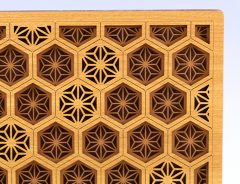- Tags:
- cross-section / osmanthus / patterns / timber / Wood
Related Article
-

These gorgeous laser-cut wooden cover notebooks feature neo-Japanesque patterns
-

Japanese Sculptor Creates Super Realistic Food Out Of Wood Blocks
-

Memo pads & sticky notes are made of thin wood used in takoyaki trays, bento boxes and more
-

Enjoy coffee & tea with Masu Presso, a drinking experience based on Japanese wooden sake cups
-

The world’s first spirits made from fermented wood to be developed and sold in Japan
-

Capture the soothing fragrance of fall with osmanthus syrup [recipe]



Osmanthus, otherwise known as sweet osmanthus, sweet olive or fragrant olive (Osmanthus fragrant), as the name suggests, emits a wonderful fragrance when its orange (or sometimes white) flowers bloom from September to October every year. In Japan, where the shrub is grown and planted throughout the country, it's a famous sign of the season when its delightful aroma wafts through the morning air, greeting children on their way to school or people commuting to work.
However, although its fragrance and its colorful orange blossom are known throughout Asia, not many people have seen a cross-section of its trunk.
Japanese Twitter user and amateur fossil collector, mineral collector and gold panner 夏樹 Natsuki (@isurusescheri) posted photos of a cross-section of an Osmanthus trunk:
Images reproduced with permission from 夏樹 Natsuki (@isurusescheri)
"The cross-section of Osmanthus wood, with interesting patterns. It's a common shrub, but I've never seen this before because it's not available in the market as timber."
What a unique and attractive pattern...!
As Natsuki pointed out, people have almost no opportunities to see Osmanthus wood on the market as timber, which is why this is a valuable photo.
The surprising images revealing yet another charm of the Osmanthus elicited many reactions such as:
Next time you see an Osmanthus, maybe you'll not only enjoy the fragrance and blossoms but also appreciate the fact that its branches hide such lovely patterns.